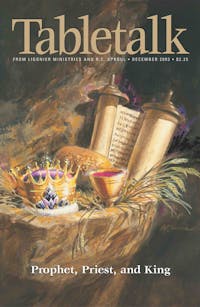
Request your free, three-month trial to Tabletalk magazine. You’ll receive the print issue monthly and gain immediate digital access to decades of archives. This trial is risk-free. No credit card required.
Try Tabletalk NowAlready receive Tabletalk magazine every month?
Verify your email address to gain unlimited access.
“Who do you say that I am?” The question that Jesus asked His disciples in Caesarea Philippi two thousand years ago remains the most significant question that any human being will ever face. Throughout her history, the church has continued to reflect on who Jesus Christ is. Much of the time, this reflection has been simply the result of a study of the teaching of the Scriptures. Many times, however, this reflection has been necessitated by the rise of false teachers in the church—men whose preaching of “another Christ” has forced the church to clarify the Biblical boundaries of orthodox doctrine.
A recent contribution to the ongoing discussion of Christology (or the doctrine of Christ) is Donald Macleod’s The Person of Christ. At the time of the book’s publication, Macleod was the professor of systematic theology at the Free Church of Scotland College in Edinburgh, Scotland. His book is part of IVP’s “Contours of Christian Theology” series, a series that also includes notable volumes by Sinclair B. Ferguson and Edmund Clowney—authors familiar to readers of Tabletalk.
In the introduction, Macleod informs his readers that he self-consciously adopts a “Christology from above” methodology. He admits that he is writing from the standpoint of one who is already convinced that Jesus Christ is the eternal Son of God.
Macleod’s book is divided into two main parts. Part One is titled “Very God of Very God: From the Gospels to Nicea.” In this part of the book, Macleod devotes considerable space to an examination of what the Bible has to say regarding subjects such as the Virgin Birth (ch. 1), the pre-existence of Christ (ch. 2), and Christ as “the Son of God” (ch. 3). In connection with these doctrines, he deals with Christological errors such as ontological subordinationism and adoptionism.
After discussing the historical skepticism that is prevalent in much modern Biblical scholarship (ch. 4), Macleod proceeds to an examination of the teaching of the Council of Nicea (ch. 5). This chapter is one of the most technical (and therefore difficult) chapters in the book for those who are studying the subject for the first time. After briefly discussing the events and teachings that led to the Council of Nicea, Macleod proceeds to explain some of the technical concepts and terminology that were involved in the Christological debates of the era. He examines the meanings of such terms as homoousia, hypostasis, ousia, persona, perichoresis, and filioque. He also examines the concepts of eternal sonship and eternal generation. His discussion of John Calvin’s doctrine of Christ is particularly helpful.
Part two of the book is titled “Very God, Very Man: To Chalcedon and Beyond.” Macleod begins this part of the book with an examination of the doctrine of the Incarnation (ch. 6). He explains that in the early years of the church there were basically two kinds of attacks being leveled against the doctrine of the Incarnation. One attack came from the Docetists, those who believed that matter was evil and therefore that Christ only seemed (Greek dokeo) to be a man. Another attack came from the Appolinarians, who believed that Christ only had a human body, not a human spirit or mind. The church’s doctrine of the Incarnation denied both attacks, insisting that Christ took a true human body and a reasonable human soul (p. 161).
In his chapter on the Council of Chalcedon (ch. 7), Macleod examines the Nestorian and Eutychian heresies. He also provides a helpful explanation of what the Chalcedonian definition means when it refers to Mary as theotokos (“God-bearer”). Perhaps the most helpful part of this chapter is Macleod’s discussion of the meaning of the “hypostatic union” (pp. 189 ff.) and the meaning of “communion in attributes” (pp. 193 ff.). Both of these doctrines are regularly confused or misunderstood by many in the church today.
Philippians 2:6–11 and the doctrine of “kenosis” are the subjects of chapter 8, while chapter 9 is devoted to questions related to the sinlessness of Christ. The final chapter summarizes some of the major voices in twentieth-century Christological discussion.
Macleod’s book is valuable for those interested in examining the Biblical doctrine of Christ as well as those interested in the doctrines set forth in the Nicene Creed and the Chalcedonian Definition. His explanation of the debates helps to clarify the very important theological issues underlying what often seem to be trivial debates over minutiae.
Because the church’s reflection on the doctrine of the person of Christ has involved discussions of numerous concepts and terms, any modern examination of this doctrine will of necessity also include a number of terms that may be unfamiliar to modern ears. Some of the chapters in Macleod’s book may, therefore, require extra time and effort. It is time and effort, however, that will be well rewarded.
